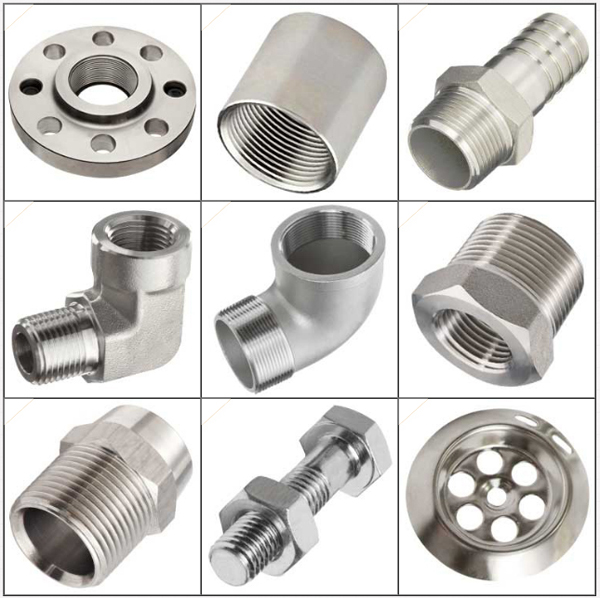
You cannot see or feel any difference between 304 stainless steel fittings and 316 stainless steel fittings. Therefore, stainless steel fittings are marked “304” or “316” to distinguish them. The only difference is the presence of a chemical element called molybdenum, which gives it more significant corrosion and oxidation resistance in 316 stainless steel fittings.
In this article, we will dive into it a bit more to better understand the difference between 304 stainless steel fittings and 360 stainless steel fittings, as well as some insight into where light and heavy pattern stainless steel fittings are typically used.
There are many types of stainless steel on the market today. The grades of the 300 series are “austenitic stainless steels,” containing high levels of chromium and nickel and low carbon, offering a balance of strength, machinability, and corrosion resistance. Austenitic Stainless Steels have the highest corrosion resistance and are the most commonly used type of stainless steel worldwide.
What is 304 Stainless Steel Fittings?
Class 304 is the most widely used ‘general application’ austenitic stainless steel. It contains between 18 and 20% chromium (Cr) and between 8 and 12% nickel (Ni), as well as small amounts of carbon (C) and manganese (Mn). Its chemical composition, mechanical properties, and corrosion/oxidation resistance provide good all-around performance at a relatively low cost compared to 316. This is another reason for its popularity and widespread use.
Application of 304 Stainless Steel Fittings
304 stainless steel fittings are commonly used for plumbing residential/commercial water wells and potable water plumbing installations. They are also excellent for many other commercial/industrial non-potable water applications requiring good corrosion resistance. They are not recommended in highly sulfurous, hydrochloric, formic, and tartaric environments.
What is 316 Stainless Steel Fittings?
316 stainless steel has a higher nickel content and a lower chromium content than 304 stainless steel. It contains between 16 and 18% chromium (Cr) and between 10 and 14% nickel (Ni), as well as small amounts of carbon (C) and manganese (Mn)., The critical difference is the addition of 2 – 3 percent molybdenum (Mo) which makes it more corrosion-resistant.
Grade 316 is more expensive; however, it offers increased corrosion resistance, especially against chlorides and chlorine solutions. 316 stainless steel is highly recommended in applications where potent corrosives, chlorides and salt exposure is an issue since it will last longer than 304.
Application of 316 Stainless Steel Fittings
316 stainless steel fittings are commonly used in marine/seawater, industrial and commercial chemical and pharmaceutical equipment, and many other non-potable water applications. They are ideal for all potable water systems, municipal water treatment plants, and pump houses. 316 stainless steel fittings are worth the expense if you want superior corrosion resistance.
Stainless steel fittings will save you in the long run by reducing system downtime, replacement, and maintenance costs over the installation’s life.
Light and Heavy Pattern Stainless Steel Fittings
Both 304 and 316 stainless steel fittings are available in light and heavy patterns.Understanding the differences will help determine the best product for your application. You can feel the difference in weight and see the difference in the thickness of their walls.
Lightweight Model 304 and 316 Stainless Steel Fittings
The ISO 4144 light pattern fittings are a cost-effective option for the MS SSP-114 pattern, as they provide the same corrosion resistance properties. The ISO4144 Standard (International Organization for Standardization) reduces the wall thickness/section diameter due to the structural strength of stainless steel alloys while maintaining similar pressure/temperature ratings. They are an excellent choice for residential/commercial drinking water systems. They can also be suitable for various non-critical applications, including industrial/commercial applications, food processing, and other non-potable water piping systems.
Heavy Model 304 and 316 Stainless Steel Fittings
MSS SP-114 was the first standard written explicitly for class 150 SS fittings. It is based on ANSI B16.3 sizes with additional requirements. It is the most comprehensive standard in use today. This heavy-duty, thick wall pattern protects against erosion due to extremely high flow rates for increased system life. Tight dimensional tolerances in installation length make the MSS SP114 the number one choice for industrial/factory installations. They are commonly used in commercial and industrial piping systems in the chemical, pulp, and paper pulp industries, oil, food & beverage, sanitary, steam, and industrial processes are subject to various stress factors.
It comes down to application. Now that you know the differences between 304 and 316 stainless steel, the next step will be determining the best pattern, light or heavy, for your application.
Just remember that the investment in either 304 or 316 stainless steel fittings will save you in the long run by reducing system downtime, replacement, and maintenance costs over the installation’s life.
Benefits of Stainless Steel Fittings
- Material Benefits. The combination of corrosion resistance with high strength allows the reduction in wall thickness and weigh Stainless steels are resistant to both thermal and chemical damage.It can withstand very high flow rates – more than 40m/s, making it capable of withstanding long-term exposure to the elements in almost any environment.
- Environmental Benefits. Stainless steel can be used in all types of water, including drinking water in public supply. It has excellent resistance to the full range of potable waters, including various chloride levels. At the end of its useful life, stainless steel is fully recyclable and retains a higher residual scrap value than ordinary steel.
- Economic Benefits. Stainless steel is low maintenance and requires no additional coating in indoor and outdoor applications. The expected lifetime of a stainless steel system is more than 50 years, reducing system downtime, replacement, and maintenance costs over the installation’s life.






